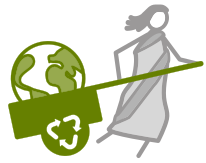India – 14 Feb 2012 –
AT THE crack of dawn, the view from atop the 22-metre tall garbage heap in Bhalswa is oddly beautiful. As the pungent smell of methane wafts through the air, the sight of hundreds of ragpickers mechanically sorting through 2,200 tonnes of garbage may seem mesmerising. Pools of black water surrounding the hutments reflect the grey sky and the birds that circle above. The reality is equally grim. The resettlement colony is a living hell and this hell has no water to drink.
Promised a better life by the Delhi government, 4,000 families were herded from slums across the city to the base of the Bhalswa landfill in 2000. As usual, a plan was drawn up, Rs 70 crore was sanctioned, but nothing was built. As the settlers went from ‘illegal’ to ‘legal’, they lost their homes, their livelihood and all basic amenities.
“Before we came here, I lived in a slum in Nizamuddin. We had clean running water, electricity, access to education and employment. Here there is nothing, only disease,” sobs Roshanara, 50, a grandmother of two.
Access to clean drinking water is a fundamental right, but the Delhi Jal Board (DJB) never installed pipelines and residents were forced to use hand pumps. What compounded the problem was that the landfill was improperly built and that resulted in the seepage of chemicals and waste contaminating the groundwater.
According to tests conducted by Hazards Centre, the water contains high levels of total dissolved solids, chemical oxygen demand (usually associated with sewage), lead, zinc and faecal matter. The water is coloured and is also found to be salty.
“Children are the worst affected,” says Tara, a young mother whose face and body are covered with rashes and scars caused by the water. “If we go to government hospitals, they just give us two pills that don’t have any effect. We are forced to spend a lot every month to go to private doctors and buy medicines.”
As she narrates her story, a neighbour brings her baby and shows the boils on his head. Soon, two boys in school uniform walk up and show marks on their faces and arms. Another woman tells the story of her daughter, “She got rashes everywhere. She would scratch so much that she would bleed. The doctor said it was because of the water, but I only believed him when we went back to my village and her rashes cleared up.”
Water-related problems are not restricted to Bhalswa. Residents of Shraddhanad colony, located directly at the base of the landfill, and Mukundpur have similar complaints.
Rashes are only the visible manifestation of the contaminants found in the water. Seventy percent of the residents in Bhalswa suffer from gastro-intestinal disease, while 70 percent suffer from musculo-skeletal pain and 40 percent from multiple eye problems.
What makes the situation worse is that even the little water supplied by the DJB is contaminated. The water from the few pipelines that it has recently laid is polluted and yellow. Apparently, the DJB is directly pumping untreated water from a nearby tubewell.
The water woes lead to fights as well. “Whenever the DJB tanker comes, there is violence. Fights always break out because there isn’t enough water for everyone as the tanker comes only once a week,” says Roshanara.
The residents have written several letters to local Congress MLA Devender Yadav, but no action was taken. Frustrated, on 31 January, the aggrieved residents called on Delhi Chief Minister Sheila Dikshit. As they handed her a bottle of Bhalswa’s black drinking water, she exclaimed, “Oh ho”, and promptly sent a letter to the DJB CEO demanding action.
Bhalswa resident Manmohan Singh has the last word. “We didn’t choose to live here, the government brought us here,” he says. “They are responsible for our welfare. We are not asking for any favours, we are only asking for our basic rights.” Read original article
Tweet

